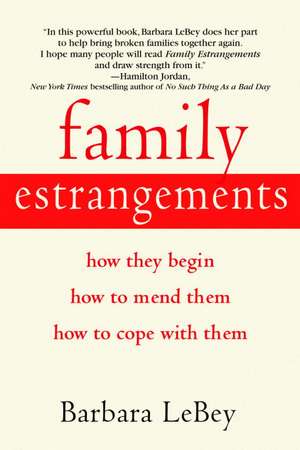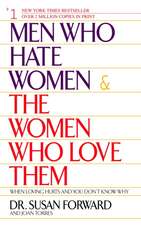Family Estrangements: How They Begin, How to Mend Them, How to Cope with Them
Autor Barbara Lebeyen Limba Engleză Paperback – 31 dec 2002
Divorce; disputes over inheritances, family business, or elder care. Rifts over marriage partners, career choices, or sexual orientation--these are just some of the many ways that even close families can break apart. Yet this all-too-common and often devastating family problem, and its emotional fallout, has gone virtually unaddressed…until now.
In this remarkable book, Barbara LeBey, an Atlanta attorney and former judge, who herself suffered and resolved a family estrangement, shares the stories of people from every walk of life and of every age and race, to show how such rifts often begin and how they can usually be resolved.
Working closely with two family therapists, LeBey offers a set of tested guidelines to help you approach alienated or angry family members, deal with your own issues, and mend your broken family relationships--even if you think it may already be too late.
Compassionate, practical, and full of rich insight, this book is a beacon of hope and healing to which families everywhere will turn again and again.
Preț: 109.73 lei
Nou
Puncte Express: 165
Preț estimativ în valută:
20.100€ • 21.84$ • 17.34£
20.100€ • 21.84$ • 17.34£
Carte disponibilă
Livrare economică 24 martie-07 aprilie
Preluare comenzi: 021 569.72.76
Specificații
ISBN-13: 9780553381962
ISBN-10: 0553381962
Pagini: 288
Dimensiuni: 150 x 233 x 16 mm
Greutate: 0.3 kg
Ediția:Bantam Trade Pb.
Editura: Bantam
ISBN-10: 0553381962
Pagini: 288
Dimensiuni: 150 x 233 x 16 mm
Greutate: 0.3 kg
Ediția:Bantam Trade Pb.
Editura: Bantam
Extras
Chapter 1
Why are families growing apart?
“Wisdom too often never comes, and so one ought not reject it merely because it comes too late.”
--Justice Felix Frankfurter
Are there more estrangements today than in the past? While there are no statistics on the subject, considering how easily I found people who have had an estrangement or are in the midst of one, it appears to be an escalating problem. We can only speculate on the reasons why. There have always been rifts in families, but they seem to be more numerous, more intense and more hurtful than ever before.
Sisters aren't speaking to each other since one sister took the silver when Mom died. Two brothers rarely visit because their wives refuse to talk to each other. A son alienates himself from his family when he marries the woman who hates everyone that was ever in his life before she was. A daughter never sees her mother because she can't stand another guilt trip. A family banishes a daughter for marrying outside her race or religion. A son repudiates a divorced father when he reveals his homosexuality. And so it goes-a variety of conflicts, misperceptions, petty grievances, prejudices and jealousies that can lead to one unhappy outcome: estrangements.
Today we are facing a rapidly changing family relationship landscape. Every assumption made about the family structure has been challenged, and once-narrow boundaries have been stretched to include single mothers raising out-of-wedlock children and gay couples having or adopting children. If the so-called conventional family is having trouble maintaining good relationships, imagine what problems can and do arise in less traditional situations. Looking back, we can see that fault lines in our family structure were widening throughout the last 40 years of the twentieth century. The cracks did not become evident until the early 1960s, when the divorce rate began to rise so sharply that it doubled by the mid-1970s. According to a 1999 Rutgers University study, divorce rates have risen 30 percent since 1970, the marriage rate has fallen faster, and only 38 percent of Americans consider themselves happy in their married state, a drop from 53 percent of happily married people 25 years ago. Today, 51 percent of all marriages end in divorce.
How Americans managed to alter their concept of marriage and family so profoundly during those 40 years is the subject of a great deal of scholarly investigation and academic debate. In a New York Times magazine article (May 2000) titled "The Pursuit of Autonomy," the writer maintains that "the family is no longer a haven; all too often a center of dysfunction, it has become one with the heartless world that surrounds it."
Unlike the past, the job that fits you in your twenties is not the job or career you'll have in your forties. Even the spouse you had in your 20s will probably not be the spouse you'll have after you've gone through your midlife crisis.
Starting with the 1960s, four sweeping societal changes have exerted an enormous influence on the traditional family structure. Many of these changes led to positive results, including but not limited to a strengthened social conscience, women's rights, constraints on going to war and a growing tolerance for diversity. But there has been a price to pay. Not only have these societal changes altered the structure of the family, but converging together, and as an unintended by-product, they fostered family alienation, exacerbated old family estrangements and created new ones. These major shifts in our American society were:
*the Me Generation of the 1960s,
*the women's liberation movement,
*the states' relaxation of divorce laws, and
*the ever-increasing mobility of American families.
Me, Me, Me! The Me Generation of the 1960s perpetuated the notion that we are first and foremost entitled to happiness and fulfillment. In America, the business of happiness has always been a growth industry. It's positively un-American not to seek it! Which goes back to that early period of our history when Thomas Jefferson dropped the final term from John Locke's specification of human rights-"life, liberty, and ... property"-and replaced it with what would become the slogan of the new nation: "the pursuit of happiness." In 1961, an advertising executive working on the Clairol hair color account came up with the catchy line: "If I've only one life, let me live it as a blond." In a sense, this neon commercial distilled the basic nature of the 1960s. Tom Wolfe, in Mauve Gloves & Madmen, Clutter & Vine, had it right when he pointed out, "If I've only one life, let me live it as a ____________!
Throughout the next decade, everyone began to fill in the blank for themselves." With the same vigor and determination demonstrated by Americans in their rush for gold, so too were these baby boomers in pursuit of their own individual destinies. This was a cultural revolution with a new perspective-whatever made me happy was acceptable. And the converse of that perspective was also true: if marriage made a spouse unhappy, the marriage was no longer acceptable. For that matter, any relationship that was failing to deliver happiness was being tossed out like an empty beer can. More recently, the pharmaceutical industry has learned how to cash in on the American obsession with feeling good by hyping mood drugs to rewire the brain circuitry for happiness through the elimination of sadness and depression.
Throughout the 1960s and 1970s, Americans were enjoying the most prolonged adolescence in their history. The predictable self-absorption of youth evolved into a philosophy of instant gratification that spread through our culture like a California brushfire. In fact, that's where it all started-at the Haight-Ashbury intersection in San Francisco where the "hippies" first congregated to be heard and celebrated. They gyrated to the music of the Beatles and the Grateful Dead, swayed to the songs of Joan Baez and Simon and Garfunkel. Yes, there were birth control pills and a sexual revolution, but also there was a growing social conscience. While longhaired women wearing headbands were reputed to be burning their bras, they were also marching beside their bearded men in opposition to the Vietnam War. Gail Sheehy in New Passages describes this generation of young people: "Pampered in the childcentric incubator of a prosperous period [the 1950s], with the invisible hand of Dr. Spock sparing the rod, members of the Vietnam Generation grew up believing they could do just about anything."
Young people fled from the confines of family to be a part of "the scene," and that scene included not only demonstrations and protest marches, but mind-altering drugs and sex for the taking. Families were frantic worrying about exactly where their adult children were and what they were doing. One thing was certain-they weren't abiding by the rules their parents and prior generations had lived by. In fact, the word was, "Don't trust anyone over 30." What better way to alienate than to believe that the parents couldn't be trusted? There were probably more estrangements between parents and their adult children during that period than ever before.
Why are families growing apart?
“Wisdom too often never comes, and so one ought not reject it merely because it comes too late.”
--Justice Felix Frankfurter
Are there more estrangements today than in the past? While there are no statistics on the subject, considering how easily I found people who have had an estrangement or are in the midst of one, it appears to be an escalating problem. We can only speculate on the reasons why. There have always been rifts in families, but they seem to be more numerous, more intense and more hurtful than ever before.
Sisters aren't speaking to each other since one sister took the silver when Mom died. Two brothers rarely visit because their wives refuse to talk to each other. A son alienates himself from his family when he marries the woman who hates everyone that was ever in his life before she was. A daughter never sees her mother because she can't stand another guilt trip. A family banishes a daughter for marrying outside her race or religion. A son repudiates a divorced father when he reveals his homosexuality. And so it goes-a variety of conflicts, misperceptions, petty grievances, prejudices and jealousies that can lead to one unhappy outcome: estrangements.
Today we are facing a rapidly changing family relationship landscape. Every assumption made about the family structure has been challenged, and once-narrow boundaries have been stretched to include single mothers raising out-of-wedlock children and gay couples having or adopting children. If the so-called conventional family is having trouble maintaining good relationships, imagine what problems can and do arise in less traditional situations. Looking back, we can see that fault lines in our family structure were widening throughout the last 40 years of the twentieth century. The cracks did not become evident until the early 1960s, when the divorce rate began to rise so sharply that it doubled by the mid-1970s. According to a 1999 Rutgers University study, divorce rates have risen 30 percent since 1970, the marriage rate has fallen faster, and only 38 percent of Americans consider themselves happy in their married state, a drop from 53 percent of happily married people 25 years ago. Today, 51 percent of all marriages end in divorce.
How Americans managed to alter their concept of marriage and family so profoundly during those 40 years is the subject of a great deal of scholarly investigation and academic debate. In a New York Times magazine article (May 2000) titled "The Pursuit of Autonomy," the writer maintains that "the family is no longer a haven; all too often a center of dysfunction, it has become one with the heartless world that surrounds it."
Unlike the past, the job that fits you in your twenties is not the job or career you'll have in your forties. Even the spouse you had in your 20s will probably not be the spouse you'll have after you've gone through your midlife crisis.
Starting with the 1960s, four sweeping societal changes have exerted an enormous influence on the traditional family structure. Many of these changes led to positive results, including but not limited to a strengthened social conscience, women's rights, constraints on going to war and a growing tolerance for diversity. But there has been a price to pay. Not only have these societal changes altered the structure of the family, but converging together, and as an unintended by-product, they fostered family alienation, exacerbated old family estrangements and created new ones. These major shifts in our American society were:
*the Me Generation of the 1960s,
*the women's liberation movement,
*the states' relaxation of divorce laws, and
*the ever-increasing mobility of American families.
Me, Me, Me! The Me Generation of the 1960s perpetuated the notion that we are first and foremost entitled to happiness and fulfillment. In America, the business of happiness has always been a growth industry. It's positively un-American not to seek it! Which goes back to that early period of our history when Thomas Jefferson dropped the final term from John Locke's specification of human rights-"life, liberty, and ... property"-and replaced it with what would become the slogan of the new nation: "the pursuit of happiness." In 1961, an advertising executive working on the Clairol hair color account came up with the catchy line: "If I've only one life, let me live it as a blond." In a sense, this neon commercial distilled the basic nature of the 1960s. Tom Wolfe, in Mauve Gloves & Madmen, Clutter & Vine, had it right when he pointed out, "If I've only one life, let me live it as a ____________!
Throughout the next decade, everyone began to fill in the blank for themselves." With the same vigor and determination demonstrated by Americans in their rush for gold, so too were these baby boomers in pursuit of their own individual destinies. This was a cultural revolution with a new perspective-whatever made me happy was acceptable. And the converse of that perspective was also true: if marriage made a spouse unhappy, the marriage was no longer acceptable. For that matter, any relationship that was failing to deliver happiness was being tossed out like an empty beer can. More recently, the pharmaceutical industry has learned how to cash in on the American obsession with feeling good by hyping mood drugs to rewire the brain circuitry for happiness through the elimination of sadness and depression.
Throughout the 1960s and 1970s, Americans were enjoying the most prolonged adolescence in their history. The predictable self-absorption of youth evolved into a philosophy of instant gratification that spread through our culture like a California brushfire. In fact, that's where it all started-at the Haight-Ashbury intersection in San Francisco where the "hippies" first congregated to be heard and celebrated. They gyrated to the music of the Beatles and the Grateful Dead, swayed to the songs of Joan Baez and Simon and Garfunkel. Yes, there were birth control pills and a sexual revolution, but also there was a growing social conscience. While longhaired women wearing headbands were reputed to be burning their bras, they were also marching beside their bearded men in opposition to the Vietnam War. Gail Sheehy in New Passages describes this generation of young people: "Pampered in the childcentric incubator of a prosperous period [the 1950s], with the invisible hand of Dr. Spock sparing the rod, members of the Vietnam Generation grew up believing they could do just about anything."
Young people fled from the confines of family to be a part of "the scene," and that scene included not only demonstrations and protest marches, but mind-altering drugs and sex for the taking. Families were frantic worrying about exactly where their adult children were and what they were doing. One thing was certain-they weren't abiding by the rules their parents and prior generations had lived by. In fact, the word was, "Don't trust anyone over 30." What better way to alienate than to believe that the parents couldn't be trusted? There were probably more estrangements between parents and their adult children during that period than ever before.
Recenzii
“Barbara LeBey has written a wise, loving, and valuable book. There isn’t a family who won’t find themselves somewhere in it or any who won’t find help here, too.”
--Anne Rivers Siddons,
“This fine book not only recognizes a problem that most people conceal in shame but also fills a void in self-help literature. Highly recommended.”
--Library Journal
“In this powerful book, Barbara LeBey does her part to help bring broken families together again. I hope many people will read Family Estrangements and draw strength from it.”
--Hamilton Jordan, New York Times bestselling author of No Such Thing As a Bad Day
--Anne Rivers Siddons,
“This fine book not only recognizes a problem that most people conceal in shame but also fills a void in self-help literature. Highly recommended.”
--Library Journal
“In this powerful book, Barbara LeBey does her part to help bring broken families together again. I hope many people will read Family Estrangements and draw strength from it.”
--Hamilton Jordan, New York Times bestselling author of No Such Thing As a Bad Day
Descriere
In this rich resource for those who have had the painful experience of being cut off by a cherished family member, LeBey offers compassionate, practical advice garnered from her years on the bench in the Georgia State Courts, and from the resolution of her own estrangement from her adult son.














